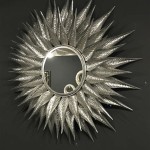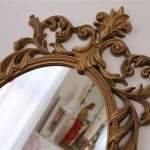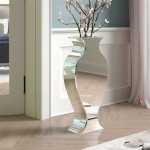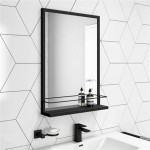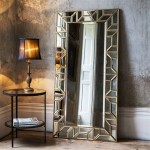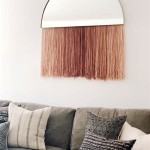Mother of Pearl Mirror: A Timeless Elegance
Mother of pearl mirrors represent a unique blend of functionality and artistry. These decorative pieces utilize the iridescent inner layer of mollusk shells, commonly known as nacre or mother of pearl, to create intricate designs and frames that enhance the reflective surface of the mirror. The result is an object that serves both a practical purpose and acts as a decorative focal point in a variety of interior design styles.
The history of mother of pearl inlay work can be traced back centuries across various cultures. Ancient Egyptians, Romans, and Chinese artisans all valued the lustrous material for its beauty and incorporated it into jewelry, furniture, and decorative objects. The technique of using mother of pearl in mirror frames likely evolved alongside these other artistic applications, with its popularity waxing and waning throughout different historical periods. The Victorian era, in particular, saw a resurgence of interest in mother of pearl inlay, including its use in mirror design.
The creation of a mother of pearl mirror is a labor-intensive process that often involves skilled artisans. The process begins with the careful selection of shells, which are sourced from various species of mollusks. Different shells offer variations in color, iridescence, and pattern. The selected shells are then cleaned and cut into small pieces, often shaped into specific designs or tiles. These pieces are meticulously arranged and inlaid onto a wooden or other suitable frame base. The arrangement can follow geometric patterns, depict floral motifs, or even form intricate scenes, showcasing the artistry of the craftsperson.
Once the mother of pearl inlay is complete, the mirror itself is carefully installed within the frame. The size and shape of the mirror can vary depending on the overall design and intended use. Smaller, hand-held mirrors might feature intricate, densely packed inlay, while larger wall mirrors might incorporate broader patterns and larger pieces of mother of pearl. A protective backing is often applied to the back of the mirror to prevent damage and secure the inlay.
The aesthetic appeal of a mother of pearl mirror lies in the unique optical properties of nacre. The iridescent shimmer, caused by the interplay of light with the layered structure of the shell material, creates a dynamic visual effect. The colors reflected can shift depending on the viewing angle and ambient lighting, adding a captivating depth and luminosity to the piece. This inherent shimmer also complements a wide range of interior styles, from traditional to contemporary.
Mother of pearl mirrors can be incorporated into a variety of interior design schemes. In traditional settings, they can add a touch of classic elegance and opulence. The iridescent sheen complements antique furniture and rich fabrics, creating a sense of timeless beauty. In more contemporary spaces, the organic patterns and natural materials of the mirror can provide a textural counterpoint to clean lines and minimalist aesthetics. The reflective surface also helps to brighten a room and create a sense of spaciousness.
Caring for a mother of pearl mirror requires attention to its delicate nature. Harsh chemicals and abrasive cleaners should be avoided as they can damage the nacre. Instead, a soft, damp cloth is generally sufficient for cleaning the mirror surface and the frame. Direct sunlight should also be avoided as prolonged exposure can cause the colors of the mother of pearl to fade over time. With proper care, a mother of pearl mirror can remain a beautiful and cherished piece for generations.
Beyond their decorative function, mother of pearl mirrors can also hold symbolic meaning. In some cultures, the iridescent shell is associated with prosperity, good luck, and protection. The reflective surface of the mirror itself can also be seen as a symbol of self-reflection and introspection. These symbolic associations can further enhance the appeal of a mother of pearl mirror, adding a layer of personal meaning to its aesthetic value.
The market for mother of pearl mirrors offers a wide range of styles, sizes, and price points. Antique mirrors, often featuring intricate hand-carved frames and aged patinas, can be highly sought after by collectors. Contemporary designs offer a modern interpretation of the classic technique, utilizing different shell types and incorporating innovative frame styles. The price of a mother of pearl mirror can vary significantly based on factors such as the size, the intricacy of the inlay work, the age of the piece, and the origin of the materials.
Choosing a mother of pearl mirror involves considering its intended use and the overall aesthetic of the space. Factors such as the size of the room, the existing décor, and the desired level of ornamentation should all be taken into account. Whether used as a focal point above a fireplace, a decorative accent in a bedroom, or a functional piece in a bathroom, a mother of pearl mirror can add a touch of timeless elegance and natural beauty to any interior.

White Mother Of Pearl Square Mirror Iris Furnishing

Quogue Mother Of Pearl Mirror 33 H X 25 W 1 D Cailini Coastal

Made Goods Sidney Rectangular Mirror Silver Mother Of Pearl S Multiple Options Clayton Gray Home

Mother Of Pearl Inlay Mirror

White S Vintage Mother Of Pearl Inlay Mirror Casbahdecor

36 X 48 Mother Of Pearl Handmade Mosaic Wall Mirror With Blue Corners Cream Olivia May Target

Syrian Mother Of Pearl Mirror Chairish

White Mother Of Pearl Inlaid Antique Middle Eastern Damascene Syrian M E Mosaik

Uma Mother Of Pearl Mirror 71 X 28 Homemakers

John Lewis Mother Of Pearl Rectangular Wall Mirror 60 X 90cm Blue

